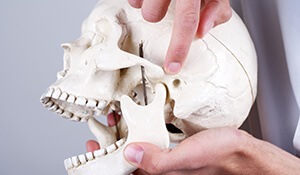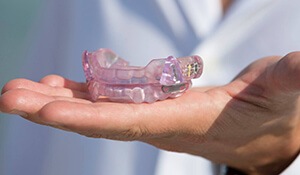Relieve Chronic Jaw Pain & Headaches with TMJ/TMD Therapy
 If you put your fingers right in front of your ears and open and close your mouth, the movement you’ll feel are your temporomandibular joints, or TMJ. These joints enable your jaw to move fluidly and easily whenever you speak, eat, or laugh. Like other joints in the body, they can become injured or strained, and this can lead to a variety of issues such as chronic pain and even headaches! Fortunately, Dr. Shelly Strohman and our team are fully capable of treating and correcting these kinds of problems. If you frequently have a stiff/sore jaw or suffer from chronic migraines, be sure to contact our office today for a TMJ evaluation.
If you put your fingers right in front of your ears and open and close your mouth, the movement you’ll feel are your temporomandibular joints, or TMJ. These joints enable your jaw to move fluidly and easily whenever you speak, eat, or laugh. Like other joints in the body, they can become injured or strained, and this can lead to a variety of issues such as chronic pain and even headaches! Fortunately, Dr. Shelly Strohman and our team are fully capable of treating and correcting these kinds of problems. If you frequently have a stiff/sore jaw or suffer from chronic migraines, be sure to contact our office today for a TMJ evaluation.
 Diagnosis & Treatment
Diagnosis & Treatment
When you come in for a standard checkup, we’ll always examine your TMJ in addition to your teeth and gums. Your jaw, neck, and head muscles are all part of a delicate system, and any one element that throws off the balance can affect the other. This is why TMJ problems can often manifest as headaches! We’ll test your jaw’s range of motion and be sure to look at your teeth to spot possible signs of misalignment. If we see anything that causes concern, we can start the proper treatment right away.
 Equilibration / Occlusal Adjustments
Equilibration / Occlusal Adjustments
Often, a slightly misaligned jaw can cause the teeth to come together incorrectly, and this can stimulate the nerves in the sockets and cause quite a bit of pain. To correct this kind of issue, we’ll do something called an equilibration/occlusal adjustment. For this, we will take an impression of your bite and measure how your teeth are coming together to find the source of your discomfort. We’ll then gently remove tiny portions of your enamel so that they glide together smoothly and make everything balanced and comfortable.
 Occlusal Splints
Occlusal Splints
An occlusal splint is a small mouthguard that can be used to address TMJ pain. It works by slightly shifting the jaw into a more comfortable position so that the muscles can relax, heal, and gradually reorient themselves into a more functional situation. You’ll only wear it when you sleep, and each one is custom made, so they are both extremely comfortable and effective. Often, patients only need to wear the splint for a few weeks or months before their jaws naturally correct themselves.